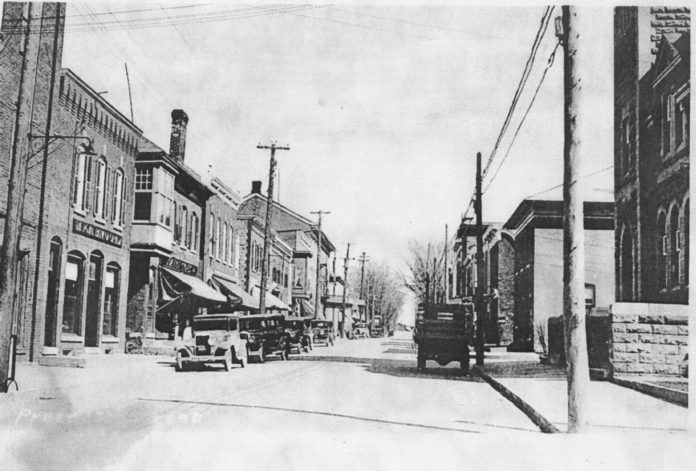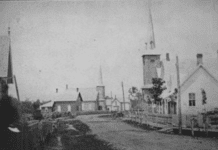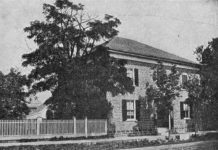The photograph shows Prescott Street at one of its high points, some time in the 1930’s. It had not always been the main street it had become by then. Until the first permanent bridge was built over the South Branch to connect it to the rest of the village, this was just the beginning of the winding trail that led to Prescott on the Saint Lawrence. It is recorded that, in the 1840’s, cattle were being grazed at the corner of what would be Prescott and Asa Streets. But the bridge, and especially the arrival of the railway in 1854, turned Prescott Street into a major artery, not only for the town, but for the entire region. It was part of the main highway from Ottawa to Prescott, and, in 1918, became just the second numbered King’s Highway in Ontario. Every car, truck and other vehicle travelled along Prescott Street as they made that journey from the Ottawa to the Saint Lawrence Rivers. In 1925, Prescott Street became a part of the new Highway 16, as the Prescott Highway was renamed.
In 1872, it experienced a devastating fire that destroyed every builing on both sides of the street, from Asa as far as Water Street. But, within a few years, it was restored, with new stone and brick buildings to replace the lost wooden ones from before the fire. By the time this photograph was taken, Prescott Street boasted three banks, two churches, several stores selling a variety of goods, a major hotel, restaurants, and other services. To the extreme right in the picture can be seen the Post Office that dominated the corner of Reuben Street. Beyond that corner is the fine residence of a local doctor. Facing them across the street is the Royal Bank, and up at the corner of Asa, the three-storey McGregor Hotel, which was itself destroyed by fire on New Year’s Eve, 1939.
Prescott had become a busy and vital street, which had once been a sleepy trail. When Highway 16 was diverted away from the downtown, and County Road 43 gave access to Winchester to the east and Merrickville to the west, Prescott Street gradually reverted to being one of Kemptville’s two main streets. When the 416 was officially opened in 1999, this process was complete. Many of the buildings in the photograph are long gone, most to fire and some to demolition. But enough remains of Kemptville’s hey day to provide residents with an historic centre and a street that is being, as so often in its past, redefined for a new age.









